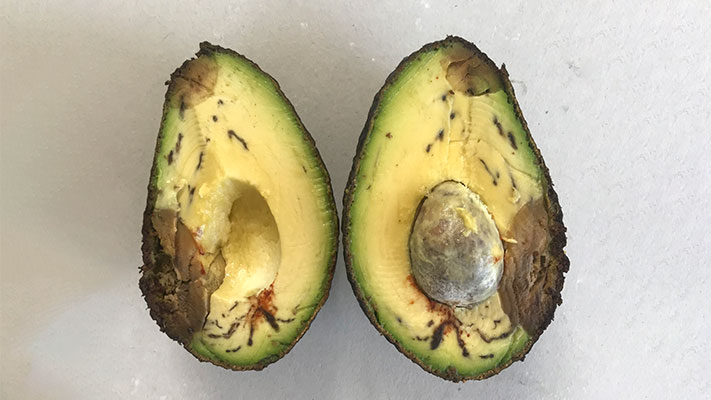Stem end rot

Description
Symptoms of SER start in the stem end of fruit, characterised by dark brown – black rot which produces a dark brown ring which progresses down the fruit. SER and anthracnose are often hard to distinguish between. The main difference is dark streaking in the water conducting tissues produced by SER, which is absent in anthracnose. Post-harvest, SER is favoured by warmer temperatures of greater than 25 °C during ripening.
Fungi responsible for causing SER are present internally in the trees vascular system. SER infection occurs by an endophytic pathway, where the fungus is already present in the fruit prior to harvest entering the fruit via the fruit stem Once infected and during the post-harvest ripening, the fungus becomes necrotic and spreads into the vascular bundles, resulting in SER. Mangos which are placed on the ground for desapping can also become infected from inoculum present in the bark, litter and soil.
Control
A holistic approach, including cultural and chemical practices should be implemented to control SER. Eliminating the primary source of inoculum, by removing dead material from within the canopy and orchard floor is recommended. Additionally, keeping an open canopy allows air to move through more easily, enabling foliage and fruit to dry quickly after rain, making it less conducive for fungal growth. Maintaining water supply during fruit development is imperative, as water stress during this phase can increase the risk of infection.
The health and nutrient status of trees is important in the management of SER. Research from New Zealand in avocados has shown higher calcium levels reduced the occurrence of SER. This research also demonstrated the use of thicker mulches and less rain prior to harvest reduced the incidence of SER. Where possible, avoid picking fruit when wet as this can increase the risk of damage and subsequent infection. Avoid harvesting immature fruit and once picked, place fruit in cool, well ventilated containers. It is suggested fruit picked from orchards with a history of SER should not be kept for long term storage. To avoid the spread of SER post-harvest, maintaining good hygiene is important, therefore packing equipment should be cleaned daily.
Chemical and biological fungicides applied pre and post-harvest, play an important role in the control of SER. To assess the severity of SER, randomly harvest 100 mature fruit and store them untreated at 25 °C until ripe. A threshold of less than one tenth and no more than one third should develop SER once ripe. If the upper limit is reached, a post-harvest fungicide may be required.
Luna® Sensation is a chemical fungicide used in-crop to control SER. Studies have shown it can contribute to a superior shelf life of fruit after harvest. Luna Sensation is registered for use in mangos and avocados to control SER. Serenade® Opti is a biological fungicide, which is best applied prior to disease symptoms developing. It is registered for the suppression of SER in avocados and mangos.
References
McCauley, D. (2020), ‘Growing Avocados – Fungal diseases of fruit’, Department of Primary Industries and Regional Development, Growing Avocados-Fungal diseases of fruit | Agriculture and Food
Queensland Government (2018), ‘Stem end rot’, Department of Agriculture and Fisheries , Stem end rot | Department of Agriculture and Fisheries, Queensland (daf.qld.gov.au)
Queensland Government (2014), ‘Management of post-harvest mango diseases’, Department of Agriculture and Fisheries, Management of post-harvest mango diseases | Department of Agriculture and Fisheries, Queensland (daf.qld.gov.au)





